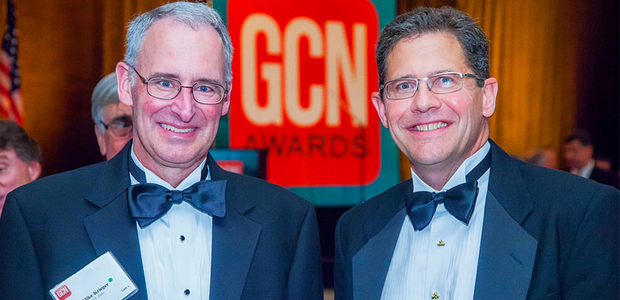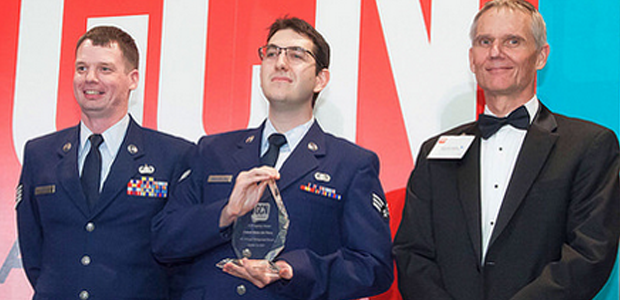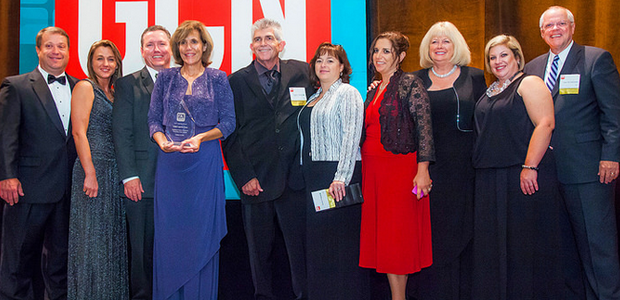GCN Gala showcases projects driven by tech and teamwork


Connecting state and local government leaders
The public sector IT community turns out to honor IT projects and leaders who showed exceptional creativity and determination in building systems that drove savings and performance in 2014.
The government IT community honored 20 standout projects – including ground-breaking efforts by the CIA to set up cloud services for the intelligence community, to a network simplifying how victims of domestic violence obtain protective orders – at the 27th annual GCN Awards Gala held this week to showcase government IT ingenuity and teamwork.
Nearly 500 government and IT industry executives turned out to honor 10 award winners, 10 honorable mentions and the work of three executives recognized for their achievements and impact across the government and commercial sides of the public sector IT market.
“Tonight we remind ourselves about the importance of what we do, why it matters and how it makes a difference, not only for United States citizens, but also for the freedoms we fight for around the world," said Kay Kapoor, president of AT&T Federal, who introduced the winning projects at this week's gala.
The 2014 GCN Awards reflected significant changes in that marketplace this year, particularly moves by security-sensitive agencies such as the CIA and the Defense Department to adopt commercial cloud services. Cloud technology in particular was a big winner at the 2014 Gala.

Army's Mike Krieger and CIA's Doug Wolfe
CIA chief information officer Doug Wolfe, honored as GCN’s 2014 Government IT Executive of the Year for his work in moving the intelligence community to the cloud, said the new technology would take on an important but simple role: to make rank and file intelligence officers more effective at their jobs.
“We didn’t do this because moving to the cloud is popular,” said Wolfe in receiving his award.
Instead, he added, the cloud services the CIA recently stood up in a $600 million deal with Amazon Web Services were acquired to enhance the ability of CIA staff to share information across the intelligence community and develop new tools to improve collaboration.
In introducing Wolfe to the crowd, Lockheed Martin executive vice president Sondra Barbour said that over a 30-year career, Wolfle had “led efforts to knock down barriers between silos of data and encouraged the adoption of IT and software to traditionally slow-moving organizations.”
Those efforts called upon elements of “innovation, collaboration and information sharing,” which Wolfe brought to the table, she said.
The Navy was also recognized for its project to move websites and low impact systems to the cloud, a winning tactic in its battle against the rising costs of maintaining unclassified data. In doing so, it cut costs in half and laid down a roadmap for IT efficiency at DOD.
Several winning projects showed how agencies have entered what might be called an era of services maturity. That was especially true of a winning project by the IT department of Alamance County, N.C., which integrated video conferencing and VPN to streamline the legal gauntlet for those seeking protection from their abusers.
Another team in the services category, from the Commonwealth of Kentucky, turned in what the GCN judges agreed was a masterpiece of services integration with kynect, Kentucky’s electronic health insurance exchange. By mid-year, 400,000 uninsured had used the services site to provide more people with private and public insurance than any other state.
Although no winning project was chosen solely for innovation in cybersecurity, its importance as a foundation technology in the public sector was symbolized by the GCN Industry Executive of the Year award to Tony Cole, vice president and global government chief technology officer at FireEye Inc.
FireEye made its mark in government by being among the first security companies to realize that a new generation of advanced threats demanded a more sophisticated set of tools, including analytics, network intelligence and continuous monitoring in order to defuse attacks before they detonate.
In receiving the award, Cole thanked colleagues at FireEye for, “allowing me to do what I feel is necessary every day to help our government as best we can to lock down their systems.
“It’s a continuous challenge with no end in sight,” he said, adding,” at least from my perspective it’s also a lot of fun.”
The power of teams and teamwork was perhaps the most weighty criteria in how the judges chose projects to be recognized this year out of 160 nominations made for this year’s class of winners.

That was especially true of a team from the Air Force Mobility Command, who without prior training in commercial software development, built an iOS app for fuel balancing calculations for the KC-10 tanker aircraft.
The lack of training didn’t stop this crew. Instead, they schooled themselves with online courses, talked to boom operators and used tools that were either free or already on hand. In the end the team’s load management system cut what had been a 46 minute calculation down to 5 minutes, saving Navy flight crews thousands of hours of flight time.
While the Air Force showed the power of teams in the area of innovation, a group from the Naval Sea Systems Command were honored for their collaboration in managing the relocation of NAVSEA headquarters in the aftermath of a shooting at the Navy Yard left 12 people dead and several others wounded.
With sensitivity and swiftness, the team from the NAVSEA Information Office led a relocation of the command, which involved rebuilding an IT infrastructure that included pulling 185 miles of new cable to support 2,500 Navy and contractor staff in less than 30 days.
Teamwork was also the hallmark of the career of Mike Krieger, the Army’s Deputy CIO/G-6, who received GCN’s Hall of Fame award for his accomplishments during a three-decades long career with the Army.
In introducing Krieger, Teresa Carlson, vice president of Global Public Sector, Amazon Web Services, called Krieger, “a champion for innovative technologies that streamline government operations,” and someone who had “worked tirelessly to create a strategic direction for the Army’s network and enterprise infrastructure.”
Krieger said the gala “highlights one of my foundational beliefs: Government is a team sport.”
The Army’s network modernization efforts in particular “wouldn’t have been possible without strong partnerships and collaboration within the Army,” he said, including DISA, Air Force, Navy, USMC and Joint Staff.
“The government can’t and doesn’t go it alone, though,” he added. “The Army and I have leaned heavily on our many outstanding industry partners, and we’ve benefitted tremendously from their innovative thinking and never-ending pursuit of more capable technology.”
“We’ve gotten this far only because you’ve been a part of our team,” he added.
Beyond the technology and teamwork, this year’s GCN Awards program also reflected changes in the makeup of the public sector IT community itself: almost half of the team leaders of the winning projects are women.

“As we bring some new awareness of and recognition to these teams at the federal, state and local levels, we can celebrate that the women on these teams are not in the shadows—7 of the 20 teams had a woman identified as the lead or co-lead,” noted Anne Armstrong, co-president and chief content officer of the 1105 Public Sector Media Group.
While the night’s festivity celebrated the past, it also looked ahead, bestowing honors on two dozen government Rising Stars. The members of the group, in the first 10 years of their federal IT careers, were picked for their contributions in the last year, “at a level far above their pay grade,” said Troy Schneider, editor-in-chief of FCW, which hosts the award program.
NEXT STORY: Agencies bring energy modeling out of the lab




